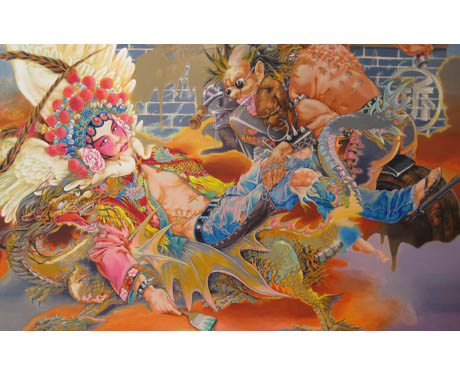 |








  
|
 |
 |



<< Return >>

LIU YAN
Fallen Angel
2008
acrylic on canvas

Below is a statement derived from conversations with Liu Yan, as well as multiple emails
and correspondence about the painting from 2007-2008.
Fallen Angel is the first painting from a series called "The Search for the Mountain Chart," based on
a story from the Song Dynasty. The tale speaks of China's mysterious Bloom Mountains, wherein demons and
monsters exist, but can be overcome by learning life's greatest lessons. The moral is derivative from the
story of Erlang Shen, a Chinese God with a third truth-seeing eye. Fallen Angel is a metaphor for
finding the truth in native tradition, and new frontiers.
This is a very important work to as it embodies what I see happening currently in struggle of the Chinese
people at this moment. In times like these, we are torn between staying in our ways and moving forward.
But sometimes, moving forward means losing sight of our past. This painting is a modern representation of
that pressure and potential for it's consequence.
Fallen Angel speaks to the changes in the Chinese culture and the trends of thought in our society. The
"punk" character represents the Western culture and the force with which it infiltrates Oriental tradition.
The female is representative of China, her body open and exposed, and already heavily influenced by Western
style. The pushing and pulling of this centralized figure by the Chinese dragon and the rebellious motorcycle
rider shows how we as the Chinese people are torn between a simple, traditional Chinese identity, and the
contemporary, fast-paced Western thought that we want to embrace. One half of her dress is a traditional
opera headpiece --the other half, ripped jeans, indicative of a highly sexualized Western culture.
The Chinese character on wall means 'to remove.' Throughout China today there are many old buildings,
old alleys, and historically important structures. These places are being completely demolished in Beijing,
because the Chinese government believes that the Western way of thought is to rebuild and make things new
and fresh. We, as Chinese citizens, are watching our culture disappear with the tearing down of these
structures. Our people are forgetting the history that is instilled in these buildings.
To the Chinese, "painting in poetry and poetry in painting" has been one of the criteria for excellence in
a work of art. Inscriptions help to explain ideas and sentiments and also add decorative beauty to the
painting. Therefore, the couplet on the right hand side translates as "the dragons and a propitious phoenix
are of two worlds." These symbols are emblematic of the change from traditional cultural to contemporary
culture, and the things within that change, and those that stay the same. To signify my appreciation for
both the Chinese culture and the Western culture, I have chosen them because we (the Chinese) consider the
Dragon and the Phoenix symbolic of blissful relations between husband and wife, as well as long life and
prosperity. Their pairing is necessary to bring about creation out of destruction.
Within this couplet, my name is also marked, as well as 2008, the year of the rat. It is timely that the
rat was welcomed in ancient times as a protector and bringer of material prosperity. Fallen Angel is a
comment on both the struggle and the beauty of our two cultures and traditions, and how we will forge through
the 21st century with both a national identity and an international perspective.
--Liu Yan
|